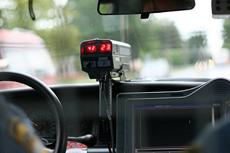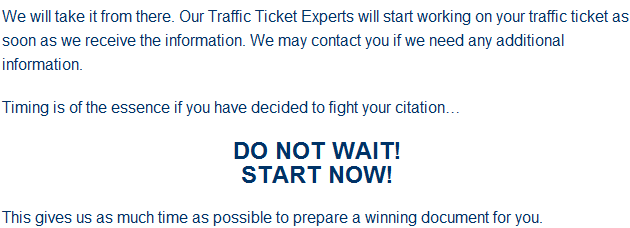
We do not require for you to appear in a trial de nova (court trial) to get our back guarantee. Even if the ticket is reduced but not dismissed we still honor our money back guarantee.
 HOW DOES SPEED RADAR OR SPEED LIDAR OR SPEED LASER WORK FOR ISSUING SPEEDING TICKETS
HOW DOES SPEED RADAR OR SPEED LIDAR OR SPEED LASER WORK FOR ISSUING SPEEDING TICKETSSpeeding tickets are issued based on evidence collected either by the use of an electronic speeding detection device or by the officer pacing the speed of a target vehicle or by observation of the speed of a vehicle over a set marked distance. The California Highway Patrol also uses a fleet of airplanes for speed enforcement by aircraft.
However, the majority of the speeding tickets are issued by the use of an electronic speed detection device. The technologies for electronic speed detection devices are called speeding ticket by RADAR, speeding ticket by LIDAR or speeding ticket by LASER.
To successfully fight speeding ticket radar a detailed knowledge of the operating principles of speeding radar and the procedural requirements for issuing a valid radar speeding ticket is necessary.
Our speeding ticket staff have many years of experience helping people fight speeding tickets with a trial by written declaration for speeding tickets by radar or speeding tickets by pacing evidence in traffic court. If you have decided to fight your ticket with trial by written declaration for speeding ticket by radar for violations of VC 22350 or VC 22349 or VC 22356 or VC 22406, we can help.

Majority of law enforcement agencies in the recent years have been replacing speed detection equipment. Now, more law enforcement agencies issue speeding tickets by lidar than speeding tickets by radar. However, Radar is still being used by most agencies for issuing speeding tickets.
The California Highway Patrol (CHP) and many of the other law enforcement agencies in California use the STALKER DUAL radar for issuing speeding tickets that can be mounted in a variety of ways in the CHP vehicles. This type of speed radar can be operated with one or two radar antennas and it can consist of any combination of K-band and Ka-band speed radar antennas.
to issue speeding ticket by radar an officer may operate the radar in Stationary Mode, Opposite Lane Moving Mode, Same direction Moving Mode and Fastest Mode for issuing speeding tickets.
Radar in Stationary Mode – Stalker Dual uses the Doppler frequency shift technique to measure the speed of moving vehicles based on the Doppler Theory that indicates a speed radar signal reflected from a moving object will experience a frequency shift that is proportional to the speed of the object relative to the radar unit. In stationary mode, the CHP officer transmits a signal using the Stalker Dual. The signal bounces back from a moving object to the antenna which processes the signal to determine the speed of the object. The CHP speed enforcement officers are able to measure the speed of vehicles approaching or moving away from the radar unit since moving objects generate the same Doppler shift moving in both directions.
Speed Radar in Opposite Lane Moving Mode – for issuing speeding tickets the radar unit must process two signals to determine the target vehicle speed. The first signal, patrol vehicle speed results from the radar signal reflecting from passing stationary objects. Since the Doppler shift is proportional to the relative velocity between the radar unit and the passing reflecting objects, the Doppler shift of this signal will be proportional to the speed of the patrol vehicle. The second radar signal results from the radar signal reflecting from an approaching or retreating opposite lane moving object and then returning to the radar unit. The Doppler shift of the radar signal will be proportional to the sum of the patrol vehicle speed and the moving object. To determine the speed the Stalker Dual radar subtracts the patrol speed from the closing moving object speed.
Same Lane Moving Mode – in the mode, two radar signals must be processed to determine the target vehicle speed. Just like radar in opposite lane moving mode, the first signal, patrol vehicle speed results from the radar signal reflecting from passing stationary objects. Since the Doppler shift is proportional to the relative velocity between the radar unit and the passing reflecting objects, the Doppler shift of this signal will be proportional to the speed of the patrol vehicle. The second radar signal is the difference speed which results from the radar signal reflecting from an approaching or retreating same lane moving object and then returning to the radar in the patrol vehicle. The Doppler shift of this signal will be proportional to the difference speed between the radar in the patrol vehicle and the moving target object. If the target vehicle is moving faster than the patrol vehicle the speed will be added to get the target vehicle speed. If the target vehicle is moving slower than the patrol vehicle the speed will be subtracted to get the target vehicle speed.
Fastest Mode Radar – This feature in the Stalker Dual radars allows the radar unit to track smaller high speed objects that normally could not be detected because of a stronger target profile would shield the smaller target object.
The term LIDAR is an acronym for Light Detection and Ranging. The term lidar is used when referring to a speed measurement device that uses laser technology for speed
Measurements. Lidar employs a time-of-flight method by taking measurements to determine the target vehicle’s speed.
When a pulse is transmitted, the timer starts to measure the time until the pulse is reflected back to the source lidar. The unit determines the speed of the target vehicle based on time-distance calculation. The lidar signal possesses the same three distinguishable characteristics as other forms of electronic wave energy such as signal speed, wavelength and frequency.
The cosine angle effect will result in a speed measurement lower than the target vehicle’s speed. The amount of the deviation between the target vehicle’s speed and the true speed will depend on the angle between the lidar unit and the target vehicle’s direction of travel.
Lidar detectors do not work as well with lidar units. Mostly due to the fact that if the lidar beam is directed at the license plate of a vehicle rather than the windshield, where the detector usually is located, the lidar beam goes undetected. The speeding evidence obtained by Radar or Lidar speed measurement is only as good as the officer presenting the evidence to the judge. In order for the evidence to be useful in traffic court it must be ruled admissible based on sufficient reason to believe that it is valid.
It is always important to determine whether the speed measurement was an accurate representation of the actual speed of the target vehicle driven by the defendant at the time of the alleged violation. The word accurate is somewhat vague. Obviously, the speed measurement could miss the true speed by an accepted tolerance and still be considered accurate. However, in order for that evidence to be admissible in court the inaccuracy should be in favor of the defendant.
To effectively fight a radar speeding ticket it is important to determine if the radar was operating properly and the radar operator had the necessary qualifications and performed properly at the time of the alleged violation. It is also very important to prove that the speed measurement came from a source other than the target vehicle.
Any arguments regarding the scientific principles of speed radar or speed lidar have been long resolved through judicial notice. Therefore, to try to argue against these accepted operational facts is not going to help fight speeding tickets by radar in traffic court.
The following are frequently asked questions for the speeding evidence collected by radar or lidar for speeding tickets:
1- I was driving next to a truck when I was pulled over for speeding ticket violation. The officer used speed radar to detect the speed of my vehicle. How can I fight speeding ticket for violation of 22349 a in court?
The newer speed radars have a feature called Fastest Mode Radar, where the officer is able to distinguish the vehicle moving faster than another vehicle with a larger radar footprint. Therefore, in these cases the common speeding ticket excuse, that the officer detected the speed of the truck and not the target vehicle, is not going to get the speeding ticket dismissed. There are several defenses in these situations. For example, it would help the case is to prove the inaccuracy of the speed radar reading based on either radar malfunction or the inability of the officer to aim the radar directly at the moving cars.
2- Can an office detect the speed of a vehicle using radar in the opposite direction?
Yes, the officer can detect the speed of the vehicles moving in the opposite direction. Additionally, if the speed radar unit is equipped with the Fastest Mode Radar, the officer will be able to see the speed of the vehicle moving at the highest speed despite the vehicle size.
3- The officer was parked on the right side of the freeway. After I passed the officer he followed me and pulled me over for a speeding ticket. But when I passed the officer I was driving below the speed limit. Is speed radar capable of detecting the speed of vehicles approaching from behind?
Yes, most radar units are equipped with two radar antennas and are capable of detecting the vehicles speed approaching the patrol vehicle from behind.
4- The officer was driving in the same direction as I was. Then, the officer slowed down. After I passed the officer he followed me and pulled me over for a speeding ticket. But when I passed the officer I was driving below the speed limit. Is speed radar capable of detecting the speed of vehicles approaching from behind?
Please see answer to #3 above. Speed radar can detect the speed of vehicles approaching from behind, even if the patrol vehicle is in motion. Basically, if the speed of a vehicle is above the speed limit by the time the driver notices the patrol vehicle on the road it is too late. The radar has already detected the speed of the vehicle.
5- Is it harder to fight speeding tickets by radar verses a Lidar speeding ticket?
Lidar is known to be more accurate than radar. Mostly due to the operating principles of lidar and the laser beam that bounced back from the speeding car. However, speeding tickets issued by Lidar are dismissed by the traffic court if it can be established that the lidar unit malfunctioned or the conditions were such that the speed reading was distorted by other factors.
6- The officer told me he clocked my speed. When I asked the officer to show me the speed radar he declined. Can I have the speeding ticket by radar dismissed based on that?
No. In most States including California the officer is not obligated to show the radar reading to the accused. Although, in some cases the officers will show the radar reading, if asked. But that still does not help.
7- The officer wrote my speed at 80 mph but when he showed me the radar the reading was 75 mph. Can a speeding ticket by radar be dismissed based on that?
No. If the speed of the vehicle is above the posted speed limit it is still a speeding violation as long as the speed recorded on the speed radar is higher than the posted speed. It is also very difficult to prove in court that the recorded speed on the radar was different than the violation speed recorded on the speeding ticket.
8- Does rain have an impact on the accuracy of speed lidar or speed radar?
Yes, most officers will not use speed radar or lidar during the rain to issue speeding tickets. The rain drops interfere with the accurate reading of the speed as sometimes the radar will record the speed of the rain drops as opposed to the speed of the target vehicle.
9- Can a speeding ticket by radar or lidar be issued while radar was used during the night?
Yes, darkness does not have an impact on the speed detection devices.
10- I was driving on a winding roadway. When I went around a curve there was an officer parked on the side of the road. Then, I was pulled over for a speeding ticket. How can the speed radar detect the speed of my car?
Speed detection Radar must be aimed at a target vehicle without any obstruction in a straight line. In this case if the defendant can establish the exact location of the officer and the location of the alleged violation for the speeding ticket, the radar evidence will not be admissible and the speeding ticket will be dismissed.
11- The officer was standing on the side of the road and when I got closer he pointed to me and I pulled over for a speeding ticket. How can the officer use radar by standing on the side of the road?
There are hand held speed radar units that are mostly used by motorcycle officers. The radar unit does not have to be installed in patrol cars.
12- The officer was hiding on a bridge crossing over the freeway and he used the speed radar from that location to issue a speeding ticket. Can radar detect the speed of a moving vehicle from the bridge?
Yes, as long as the vehicle is within the radar cone the speed of a moving vehicle can be detected.
For information on how to fight speeding tickets for violation of VC 22350 click on the highlighted text.
Most likely the reason you are on this website is that you were issued a Traffic Ticket in California. If so, you are in the right place. If you have decided to contest a traffic ticket with a trial by written declaration we can help prepare your documents for you. We specialize in fighting traffic tickets for infractions and over many years and we have helped thousands of people to successfully beat their traffic tickets.
Traffic tickets can damage a person’s driving record and consequently impact automobile insurance premiums and cost a lot of money over the years. So, if you have decided to contest your traffic ticket we can help by preparing all the necessary documents for you for a trial by written declaration with the goal of getting a dismissal of the ticket.
We offer a 100% Money Back Guarantee of our $99 flat fee in the event that the traffic ticket is not dismissed. NO Gimmicks, No Forms to fill, No Hoops to jump through. Just send us the court’s decision letter showing you were found guilty and the ticket was not dismissed. After we verify the information, we will issue you a 100% refund of our $99 flat fee. It’s that simple, see Our Guarantee Page.
Legal Disclaimer and Notice to Consumer: The information obtained from 2FixYourTrafficTicket.com hereafter referred to as FYTT and this website is intended to provide you only with general information. In short, the use of this website and the free informational or educational materials and any services provided by FYTT is not legal advice and it is not a substitute for advice from an attorney and should be used on “as is” basis. The Services of FYTT are provided by a registered and bonded Legal Document Assistant in LA County LDA2014166284 Valid through 6/17/2024. You may contact LA County registrar recorder at P.O. BOX 1208 Norwalk, CA 90650 or at 562--462-2177 or at lavote. net. A Legal Document Assistant cannot provide legal advice and can only provide self-help services like preparing, completing, or filing legal documents or forms at your specific direction and supplying you with attorney-approved written material for your self-help needs. If you choose to use this site or services provided by FYTT you agree that the free information provided on this website and information given by FYTT representatives, employees, attorneys or agents is not legal advice and no Attorney-Client relationship is created. FYTT is NOT A LAW FIRM, does not practice law, does not give legal advice, any opinion or recommendations about legal remedies, legal rights, legal defenses, or legal options. FYTT is allowed to complete legal documents in a professional and ministerial manner at the specific direction of the client. The representatives, agents and principles of FYTT are not acting as your attorney. Instead, you are representing yourself in any legal matter you undertake with the use of FYTT’s services regarding your traffic ticket. You may contact us at 6442 Platt Avenue, #203, West Hills, CA 91307 or 877--814-7542.